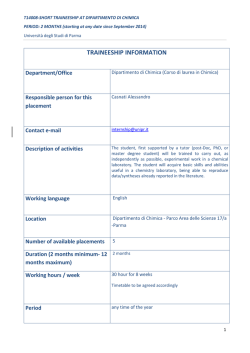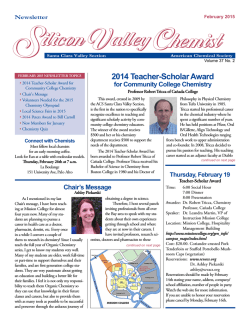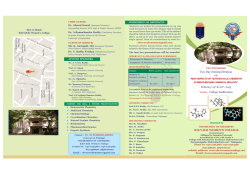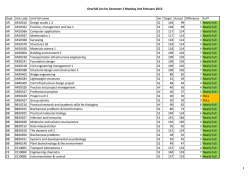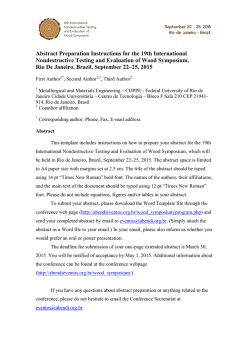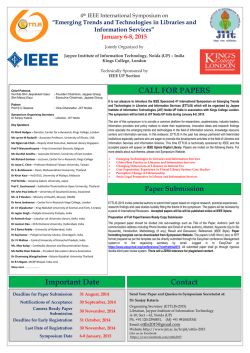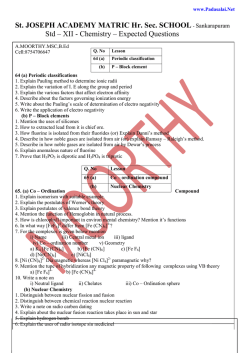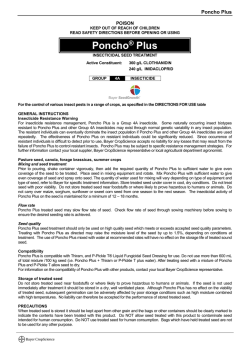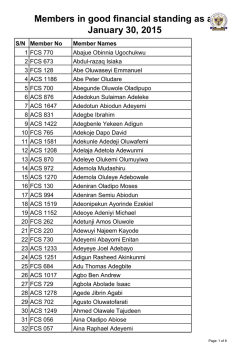
current issue - The Indicator
FEBRUARY 2015 Vol. 96 • No. 2 ISSN0019-6924 Celebrate Our Project SEED Coordinators Susan Fahrenholtz Nadia Makar Jeannette Brown See article on page 23. PLEASE RECYCLE THIS PAPER www.theindicator.org www.njacs.org www.newyorkacs.org 2 THE INDICATOR-FEBRUARY 2015 THIS MONTH IN CHEMICAL HISTORY Harold Goldwhite, California State University, Los Angeles • [email protected] Let me take you back to 1843 and a dip into “The Year Book of Facts in Science and Art” (I wish I could reproduce the delicious Victorian typography of the original), the earliest in the series that I recently acquired. Published in London by Tilt and Bogue of Fleet Street, the slim and small volume, crammed with information in a tiny type face, is profusely illustrated. The front illustrations are devoted to earth science and paleontology, with a splendid skeletal rendering of “The Missouri Leviathan” , based on fossils found in 1838 in that state. The leviathan was an extinct member of the mastodon family. But let me turn to chemical science in 1843. MM. Marchond and Erdmann have reported on new determinations of atomic weights with a view to proving Proutʼs hypothesis - that all atomic weights are integral multiples of that of hydrogen - is correct. Oxygen, carbon, nitrogen, calcium, and silver fall nicely into line (go and check your atomic weight table) but their result for chlorine at 36 is outside acceptable limits even for 1843. An adjacent paragraph mentions that Laurent and Berzelius get results for chlorine that are not in accord with Proutʼs hypothesis. There is a long report by Lyon Playfair on Liebigʼs celebrated book on Organic Chemistry as Applied to Physiology and Pathology, but that topic is so important that I plan to devote a whole column to it in the near future. Mr. Marsh, of the celebrated test for arsenic, reports a new and improved process for the preparation of gaseous oxygen which consists of heating powdered potassium chlorate with a small admixture of manganese dioxide, a preparative method repeated in thousands of elementary chemistry texts and laboratory courses to this very day. New experiments by M. Magnus on the coefficient of dilatation of elastic fluids (coefficients of thermal expansion of gases in current scientific language) have shown that this coefficient, accepted generally to be 1/480 for each degree Fahrenheit, actually is slightly different for different gases. A preparation of noiseless Congreves (chemical matches) is reported by Dr. Boettger. The crackling of ordinary Congreves, according to Boettger, is due to the potassium chlorate they contain. The least noise is observed from a mixture of gum Arabic, phosphorus, saltpeter, and vermilion. “In order to prevent the injurious influence of the atmosphere on the mass, it is advisable to cover the points of the matches, after being dipped and dried, with a dilute varnish of copal, or with a solution of gum containing saltpeter.” Mr. Croft read to the British Association (for the Advancement of Science) a paper by Professor Bunsen “On Kakodylic Acid, and the Sulphurets of Kakodyl”. Bunsen did extensive researches on cacodyl (modern spelling) which we now recognize as the dimethylarsino group. The 1840ʼs were a period in which attempts were being made to organize organic chemistry in terms of radicles (1840ʼs spelling) which were advanced as being to organic compounds as the elements were to inorganic compounds. Liebig and Woehler characterized the first organic radicle, the benzoyl radicle, in 1832. Bunsenʼs work on cacodyl cost him dearly; an explosion lost him the sight of one eye. But he persevered, as this article shows, characterizing bis(dimethylarsino) sulfide, and disulfide and the acid we call dimethylarsonic acid, “A very remarkable fact with respect to this body [the acid] is, that the poisonous properties of the arsenic seem totally annihilated; eight grains administered to a rabbit exerted no poisonous action.” Incidentally Bunsenʼs “free” cacodyl radicle was later shown to be the dimer tetramethyldiarsine. I will close this brief look at some of the significant chemistry reported in 1843 with a comment about another well-known compound. Nicotine was first isolated in a state of purity by the great French analyst Vauquelin in 1809. M. Barrul presented a refined analysis of nicotine in 1843 and reported on some of its properties: “… a powerful alkali, under the form of a liquid, with a very low equivalent …as compared with other vegetable alkalis. It is also a very energetic poison: a single dropp placed on the tongue of a middle-sized dog, killed him in three minutes.” THE INDICATOR-FEBRUARY 2015 3 THE INDICATOR Manager / Editor - LINDA ATKINS 1 Milbark Court, Homosassa, FL 34446 973-981-4383; Fax 352-503-7613 [email protected] Advertising Manager - VINCENT GALE MBO Services, PO Box 1150 Marshfield, MA 02050-1150 781-837-0424 [email protected] INDICATOR COMMITTEE Chair, DR. LES McQUIRE 17 Crown Drive, Warren, NJ 07059 908-334-5473 [email protected] New York Section Rep. DR. NEIL JESPERSEN Chemistry Dept., St. Johnʼs University 8000 Utopia Parkway, Jamaica, NY 11439 718-990-5221 [email protected] North Jersey Section Rep. JACQUELINE ERICKSON GSK, 1500 Littleton Road, Parsippany, NJ 07054 973-889-2368 [email protected] Web Masters NY Section - DR. BRIAN GIBNEY [email protected] NoJ Section - PAUL TUKEY [email protected] NEW YORK SECTION http://newyorkacs.org Chair, DR. PARIS SVORONOS Department of Chemistry CUNY-Queensborough Community College 222-05 56th Avenue, Bayside, NY 11364 718-631-7695 • [email protected] Chair-Elect, DR. ALISON HYSLOP Department of Chemistry, St. Johnʼs University 8000 Utopia Parkway, Jamaica, NY 11439 718-990-6297 • [email protected] Secretary, DR. JOSEPH M. SERAFIN Dept. of Chemistry, St. Johnʼs University 8000 Utopia Parkway, Jamaica, NY 11439 718-990-5226 • [email protected] Section Office St. Johnʼs University, Chemistry Dept. 8000 Utopia Parkway, Jamaica, NY 11439 516-883-7510; Fax 516-883-4003 [email protected] NORTH JERSEY SECTION http://www.njacs.org Chair, DR. RONALD KONG 212 Beech Drive N., River Edge, NJ 07661-1110 201-707-3899 • [email protected] Chair-Elect, DR. LUCIANO MUELLER Senior Research Fellow, Department of Lead Discovery and Optimization, Bristol-Myers Squibb Route 206 & Provinceline Rd., Princeton, NJ 08543 609-252-4360 • [email protected] Secretary, BETTYANN HOWSON 49 Pippins Way, Morris Township, NJ 07960 973-822-2575 • [email protected] Section Office 49 Pippins Way, Morris Township, NJ 07960 973-822-2575 • [email protected] The monthly newsletter of the New York & North Jersey Sections of the American Chemical Society. Published jointly by the two sections. CONTENTS Advertisersʼ Index . . . . . . . . . . . . . . . . .24 Call for Papers . . . . . . . . . . . . . . . . . . . 21 Call for Volunteers . . . . . . . . . . . . . . . . 22 New York Meetings . . . . . . . . . . . . . . . .5-9 Nichols Symposium . . . . . . . . . . . . .12-13 North Jersey Creativity Symposium .18-19 North Jersey New Member Social . . 20-21 North Jersey Meetings . . . . . . . . . . . 15-16 Pittcon . . . . . . . . . . . . . . . . . . . . . . . . . .22 Professional/Product Directory . . . . . . . 24 Project SEED Coordinators . . . . . . . . . 23 EDITORIAL DEADLINES March April May June September October November December January 2016 February 2016 January 20, 2015 February 20 March 20 April 20 July 20 August 20 September 20 October 20 November 20, 2015 December 20, 2015 Visit Us www.TheIndicator.org The Indicator (ISSN0019-6924) is published on-line monthly except July and August by the New York and North Jersey Sections of the American Chemical Society, Office of Publication, 1 Milbark Court, Homosassa, FL 34446. All views expressed are those of the editor and contributors and do not necessarily represent the official position of the New York and North Jersey Sections of the American Chemical Society unless so stated. Distributed electronically to members through the website www.TheIndicator.org. Nonmembers are invited to read it online. Members should register their email addresses at www.acs.org/editmyprofile. Address advertising correspondence to Advertising Manager. Other correspondence to the Editor. 4 THE INDICATOR-FEBRUARY 2015 February Calendar NEW YORK SECTION NORTH JERSEY SECTION Tuesday, February 3, 2015 NY Nanoscience Discussion Group See page 5. Thursday, Februry 5, 2015 Long Island Subsection See page 6. Thursday, February 7, 2015 20th Annual HS Poster Session See page 6. Wednesday, February 11, 2015 Westchester Chemical Society See page 7. Friday, February 13, 2015 New York Section Board Meeting See page 5. Tuesday, February 24, 2015 Biochemical Topical Group See page 8. Friday, February 27, 2015 High School Teachers Topical Group See pages 8-9. Monday, February 9, 2015 Careers in Transition See page 15. also Thursdays, March 5, April 2, and Friday, April 24, 2015 Long Island Subsection See page 9. Thursday, March 26, 2015; Wednesday, April 22, 2015; and Early October 2015 Westchester Chemical Society See page 10. Tuesday, AprIl 7, 2015 NY Nanoscience Discussion Group See page 5. Saturday, May 9, 2015 63rd Annual URS See page 11. Tuesday, February 10, 2015 Drug Metabolism Discussion Group See page 16. Tuesday, February 10, 2015 Mass Spectrometry Topical Group See page 16. Wednesday, February 18, 2015 NMR Topical Group See page 16. Monday, February 23, 2015 North Jersey Executive Committee See page 15. Tuesday, February 24, 2015 Younger Chemists Committee See page 16. also Monday, April 27, 2015 Drug Metabolism Discussion Group Spring Symposium and Vendor Exposition See page 17. Sunday-Friday, June 7-12, 2015 Drew University Res-Med Seminar See page 17. The Indicator is posted to the web on the 15th of the previous month at www.TheIndicator.org Deadline for items to be included in the March 2015 issue of The Indicator is January 20, 2015 THE INDICATOR-FEBRUARY 2015 New York Meetings www.newyorkacs.org 5 NEW YORK NANOSCIENCE DISCUSSION GROUP 2014-2015 Sessions Speakers to be announced NEW YORK SECTION BOARD MEETING DATES FOR 2015 Hosted by: New York University Department of Chemistry The dates for the Board Meetings of the ACS New York Section for 2015 have been selected and approved. The meetings are open to all – everybody is welcome. All nonboard members who would like to attend any (or all) meetings ought to inform the New York Section office by emailing Mrs. Marilyn Jespersen at njesper1@ optonline.net or by calling the Section office at (516) 883-7510. The NYNDG is an ACS Topical Group that meets in the New York University Department of Chemistry. Sessions feature three 30-minute presentations on nanoscience, one each with strong orientation in biology, chemistry, and physics/applied mathematics. Presentations will be focused on discussion of recent work, although speakers will place the work in a context understandable to a broad audience. All 2015 Board Meetings will be held on the following dates at St. Johnʼs University, 8000 Utopia Parkway, Jamaica, NY. Dr. Paris Svoronos will chair all meetings. Refreshments will be available starting at 6:00 PM while the actual meeting will start at exactly 6:30 PM. Please check Marilyn Jespersen for the exact building and room number. You may also be added in the mailing list if you so desire. Mark your Calendars! Friday, February 13, 2015 Friday, April 24, 2015 Friday, June 5, 2015 Friday September 18, 2015 Friday November 20, 2015 In addition please mark your calendar with the dates of the following major events: Friday, April 17, 2015, William H. Nichols Medal Award Symposium and Dinner, Crowne Plaza Hotel, White Plains, NY More information will be posted in future monthly issues of The Indicator and on the New York website at http://www.NewYorkACS.org. Dates: Tuesday, February 3, 2015 Tuesday, April 7, 2015 Times: Refreshments at 7:00 PM Science at 7:30 p.m. Place: NYU Silver Center Room 1003 (10th floor) 31 Washington Place (between Washington Square East and Greene Street) New York, NY For more information, contact: James Canary ([email protected]) Topical Group History: http://www.nyu.edu/projects/ nanoscience 6 THE INDICATOR-FEBRUARY 2015 LONG ISLAND SUBSECTION Discovery and Development of Purine-scaffold Hsp90 Inhibitors for the Treatment of Cancer Speaker: Tony Taldone, PhD Senior Research Scientist Memorial Sloan Kettering Cancer Center Heat shock protein 90 (Hsp90) is a molecular chaperone exploited by cancer cells to aid in their survival. The recognition of Hsp90 as a critical facilitator for oncogene addiction and survival of cancer cells has opened a promising new niche for cancer treatment. The serendipitous discovery that the broad spectrum anticancer activity of the natural products geldanamycin (GM) and radicicol (RD) was a result of inhibition of Hsp90 resulted in the development of improved derivatives of these natural products. One of these was 17-AAG, a closely related analog of GM, and was in fact the first Hsp90 inhibitor to enter the clinic. However, GM and its analogs suffer from poor "drug-like" properties and this served as a strong impetus for the development of novel synthetic Hsp90 inhibitors. One class to exhibit enhanced potency and improved pharmacokinetic properties is the purinescaffold. A number of small-molecule Hsp90 inhibitors based on the purine-scaffold are currently being evaluated in clinical trials for cancer. Here, I will discuss their initial discovery and development into potential anticancer agents. Date: Thursday, February 5, 2015 Times: Social – 5:30 PM Seminar – 6:00 PM Place: CUNY Queensborough Community College Science Building, S-112 Directions: http://www.qcc.cuny.edu/ about/driving.html t NEW YORK SECTION OF ACS AND ST. JOSEPHʼS COLLEGE 20th Annual High School Poster Session Sponsored by: The New York Section of the American Chemical Society and St. Josephʼs College The annual poster session provides an opportunity for talented high school students from the metropolitan area to compete and be recognized for their research accom- plishments. The program includes: • Judging of posters by scientists wrking in industry and academia • Guest speaker: Carlo Yuvienco, PhD, Physical Sciences Department, St. Josephʼs Collee • Certificates to all participants • Prizes to the four winning presenters. Protein-based Drug Delivery Agents Featured Keynote Speaker: Carlo Yuvienco, PhD PhysicalSciences Department St. Josephʼs College With the advancement of technologies to probe and manipulate biophysical matter, the scientific community continues to ever better engineer biological systems with the complexity and elegance in design that is necessary to address biomedical challenges. The growing maturity of the field of protein engineering is a testament to this proclamation. Dr. Carlo Yuvienco holds a PhD in Biomedical Engineering from New York University and a BE in Chemical Engineering from the Cooper Union for the Advancement of Science and Art. His research focus is currently the application of engineered protein constructs for drug delivery applications. Date: Saturday, February 7, 2015 Times: 9:00 AM - 1:00 PM Place: St. Josephʼs College 245 Clinton Avenue Brooklyn, NY For more information or to register visit: www.sjcny.edu/postersession. Professionals willing to be a judge, please contact Rhomesia Ramkellowan at [email protected] or [email protected]. (Include HS Poster Session in the subject line). THE INDICATOR-FEBRUARY 2015 WESTCHESTER CHEMICAL SOCIETY WINTER/SPRING MEETINGS Special Seminar – “Anammox: Nitrogen Removal for the 21st Century” Speaker: Mahsa Mehrdad Research Associate (Ph.D. Candidate) Department of Civil Engineering, Environmental Engineering Program The City College of New York New York, NY The requirement to minimize the impact of domestic effluent on public and environmental health is an important component of wastewater treatment. Removal of nutrients such as nitrogen and phosphorus is a big concern as the combination of these two can cause uncontrolled algae blooms, which choke waterways. As the discharge permit limits the amount of nitrogen for New York Cityʼs waste water treatment plants (WWTPs), New York City Environmental Protection (NYCEP) embarked on a comprehensive nitrogen control program by implementing biological nitrogen removal (BNR) technologies in the main flow of its plants and separate sidestream treatment for centrate, an internal high ammonia concentration sidestream generated during the dewatering of the anaerobic digested sludge. Typically, ammonia is converted to nitrogen gas in a two-step nitrification/denitrification process. This nitrogen removal method entails significant use of energy for aeration, chemicals to supplement alkalinity, and carbon which accounts for most of the operating costs. A more promising method is the anammox process which further reduces the energy cost, reduces the alkalinity required, eliminates the need for a carbon source, reduces the production of sludge solids, and diminishes the carbon footprint. In 2011, NYCEP in conjunction with City College of New York (CCNY) assessed the application of the anammox process in centrate treatment using a moving bed biofilm reactor (MBBR) located at the 26th Ward wastewater treatment plant, in Brooklyn, NY. Up to 70% nitrogen removal was achieved without alkalinity addition. Ms. Mehrdad studied Chemical Engineering at Amirkabir University of Technology (Tehran Polytechnic), Tehran, Iran (BS, 7 2007, and MS, 2010). During these studies, she was an intern in petrochemical process engineering at Sazeh Consultants Company in Tehran and a research assistant to Prof. Babak Bonakdar at Amirkabir University studying the catalytic effects of different redox mediators on the decolorization of azo dyes in a Sequencing Batch Reactor. In 2010, she was awarded a PhD fellowship by the City College of New York and joined Professor John Fillosʼs research group. As a part of the research group, she was involved in the operation and performance optimization of the anammox MBBR pilot at 26th Ward wastewater treatment plant. Her independent activities included the mathematical modeling of the process and the investigation of microbial population diversity. Wednesday, February 11, 2015 Times: Refreshments 5:30 PM Lecture 6:00 PM Place: Westchester Community College Gateway Building, Room 110 75 Grasslands Road Valhalla, NY Cost: Free and Open to the Public Further Information: Paul Dillon [email protected] (914) 393-6940 Or: Anthony Durante [email protected] (718) 289-5542 or 5569 Note: Inclement Weather: Cancellation Due to Inclement Weather Should Westchester Community College's Valhalla campus close due to inclement weather (or has delayed opening or closes early) the meeting will be cancelled. Decisions about delay/closure are made around 6:00 AM for day courses and 3:00 PM for evening courses. The college will communicate delays, closings or early dismissals on their website (www.sunywcc.edu), Facebook, Twitter, and the (914) 606-6900 phone line. 8 THE INDICATOR-FEBRUARY 2015 BIOCHEMICAL TOPICAL GROUP — JOINT MEETING WITH THE NY ACADEMY OF SCIENCES BIOCHEMICAL PHARMACOLOGY DISCUSSION GROUP Harnessing the Potential of Genome Editing for Drug Discovery: Translational Frontiers of in vitro and in vivo Applications Organizers: Mercedes Beyna, MS Pfizer Mi Cai, PhD Pfizer Sandra J. Engle, PhD Pfizer Samuel Hasson, PhD Pfizer Sonya Dougal, PhD The New York Academy of Sciences Speakers: Chad Cowen, PhD Massachusetts General Hospital James Inglese, PhD National Center for Advancing Translational Sciences (NCATS) J. Keith Joung, MD, PhD Massachusetts General Hospital Randall Platt, MSc Massachusetts Institute of Technology Lei (Stanley) Qi, PhD University of California San Francisco Yi Yang, PhD Novartis Institutes for Biomedical Research The emergence of genome editing technologies such as TALEN and CRISPR/Cas9 are revolutionizing our ability to rapidly engineer mammalian systems. This symposium explores the frontiers of genome editing and potential to aid therapeutic development. Abstract submissions are invited for a poster session; several abstracts will be selected for short presentations. For instructions, please send an e-mail to [email protected] with the words “Abstract Information” in the subject line. The deadline for abstract submission is January 23, 2015. Date: Time: Tuesday, February 24, 2015 8:30 AM – 4:30 PM (reception to follow) Place: The New York Academy of Sciences 7 World Trade Center 250 Greenwich Street – 40th Floor New York, NY 10007 Cost: This event is has reduced-rate registration for ACS and NYAS members, at $30 or $15 (for students and post-docs). Please select the appropriate non-member Registration Category and use the Priority Code ACS. Non-members may attend for a fee of $85 (corporate), $65 (non-profit or academic) or $45 (students and post-docs). For more information and to register for the event, go to: www.nyas.org/GenomeEditing. To become a Member of the Academy, visit www.nyas.org/benefits Z HIGH SCHOOL TEACHERS TOPICAL GROUPi Materials Chemistry in a Virtual Laboratory: Structure, Transport, and Functionalization Speaker: Mark E. Tuckerman Department of Chemistry and Courant Institute of Mathematical Sciences New York University [email protected] The design and characterization of new materials requires an integrative approach involving a synergy between theory/ mathematical modeling, computation, experimentation, and engineering. In this synergy, theory and computation are playing an increasingly important role as the power of high-performance computing architectures and sophistication of the underlying algorithms increase. In this talk, I will describe the efforts being made in my research group to develop new computational methodologies that address specific applications in materials chemistry. Specifically, I will outline our strategy for enhancing sampling of conformational equilibria in complex systems and demonstrate its performance in the prediction polymorphism in molecular crystals and the exploration of biomolecular structure. I will also THE INDICATOR-FEBRUARY 2015 9 review our work employing firstprinciples dynamics in the study of proton transport processes underlying many electrochemical devices. Finally, I will discuss our recent efforts to understand and design new candidates for the functionalization of semiconductor surfaces through the creation of organic/semiconductor interfaces. LONG ISLAND SUBSECTION Date: Friday, February 27, 2015 Time: Social and Dinner — 5:45 PM Place: White Oak Tavern 21 Waverly Place NE corner at Greene Street (site of the former M&G Pub) New York, NY Time: Meeting — 7:15 PM Place: New York University Silver Center Room 207 32 Waverly Place (South-east corner Washington Sq. East) New York, NY3 Date: Security at NYU requires that you show a picture ID to enter the building In case of unexpected severe weather, call John Roeder, (212) 497-6500, between 9:00 AM and 2:00 PM to verify that meeting is still on; (516) 385-4698 for other info. Note: On street parking is free after 6:00 PM. l EMPLOYMENT AND PROFESSIONAL RELATIONS COMMITTEE OF THE NEW YORK SECTION To Human Resources Departments in Industry and Academia The Employment and Professional Relations Committee maintains a roster of candidates who are ACS members seeking a position in the New York metropolitan area. If you have job openings and would like qualified candidates to contact you, please send a brief job description and educational/ experience background required to [email protected]. Candidates from our roster who meet the requirements you describe will be asked to contact you. Upcoming Meetings “Spice Tales”: Rapid Detection and Quantification of Synthetic Cannabinoids Speaker: Ling Huang, PhD Department of Chemistry Hofstra University Thursday, March 5, 2015 **** Electrophilic Cyclizations of Alkynes–Facile Approaches to Heterocyclic and Carbocyclic Molecules Speaker: Yu Chen, PhD Department of Chemistry Queens College Date: Thursday, April 2, 2015 **** The 15th Annual LI-ACS Chemistry Challenge The Long Island subsection of the NY-ACS invites you to participate in the 15th Annual Chemistry Challenge, to be held at CUNY Queensborough Community College. The Chemistry Challenge is a fun, fast-paced “Jeopardy-style” competition between Chemistry students of local colleges. Timed, multiple choice questions (~75% General and 25% Organic Chemistry) will be asked during the competition. Students will discuss the questions with their team members and select a final answer using electronic “Clickers.” Medals and prizes will be awarded to the top student teams. The atmosphere is exciting and brings both students and mentors together! To register a student team or obtain more information, please contact Paul Sideris at [email protected]. To view photographs from prior Chemistry Challenge events, please visit: http://www.qcc.cuny. edu/chemistry/chemchallwinner.html Date: Friday, April 24, 2015 Times: Dinner – 5:00 PM Chemistry Challenge – 6:00 PM Place: CUNY Queensborough Community College Science Building, S-111 Directions: http://www.qcc.cuny.edu/ about/driving.html 10 THE INDICATOR-FEBRUARY 2015 WESTCHESTER CHEMICAL SOCIETY WINTER/SPRING MEETINGS Special Seminar – “Nanoscience of Graphene and Other Two-dimensional Materials” Speaker: Phaedon Avouris, PhD IBM Fellow Manager, Nanometer Scale Science & Technology IBM Research Division T.J. Watson Research Center Yorktown Heights, NY Abstract and CV will be supplied in a later issue. Date: Thursday, March 26, 2015 Times, Place, Cost and Further Information: See information on page 7. **** Special Seminar – “Hydrogen Bonding in Redox and Nanoparticle Construction” Speaker: Marc A. Walters, PhD Department of Chemistry New York University New York, NY Abstract and CV will be supplied in a later issue. Tentative Date: Wednesday, April 22, 2015 Times, Place, Cost and Further Information: See information on page 7. **** Special Seminar – “How Your Grandmother's Diet May Have Changed Your Life” Speaker: Hailey Clancy, PhD Lieutenant Colonel, US Army Assistant Professor Department of Chemistry and Life Science United States Military Academy West Point, NY Abstract will be supplied in a later issue. Lieutenant Colonel Hailey Clancy graduated from Westminster College in Fulton, Missouri with a double major in Biology and Spanish and was commissioned into the US Army in 1992. While on active duty with the US Army, she earned a MS Degree in Environmental Toxicology from Cornell University where she developed a biosensor to detect the bacterium that causes Anthrax. In 2012 she earned a PhD in Molecular Toxicology and Carcinogenesis from New York University, where she conducted research on the effects of human exposure to nickel and its role in lung cancer. LTC Clancy's military assignments include service as a Transportation and Logistics officer in Germany (Nürnburg, Kaiserslautern, Wiesbaden, and Baumholder), BosniaHerzegovina, Iraq (Balad, Diyala, Baghdad), and Fort Drum, NY. She is currently assigned as an Assistant Professor in the Department of Chemistry and Life Science at West Point, NY, where she teaches General Chemistry and Biology. Her military awards include the Bronze Star (with oak leaf cluster), Meritorious Service Medal (with two oak leaf clusters), Joint Service Commendation Medal, Army Commendation Medal (with oak leaf cluster), Army Achievement Medal (with oak leaf cluster) and the Meritorious Unit Citation. Tentative Date: Early October, 2015 Times, Place, Cost and Further Information: See information on page 7. = WESTCHESTER CHEMICAL SOCIETY In 2015 the board of directors for the Westchester sub-section will remain the same but there will be some changes in officers. Specifically, Dr. Rolande Hodel will share chairmanship duties with Dr. Paul Dillon as Co-Chairmen. Dr. Dillon will continue as Co-Program Director along with Dr. Anthony Durante. Continuing in their current positions are Dr. Peter Corfield as Treasurer and Education Director, Dr. Jody Reifenberg as Westchester Community College Liaison and Insurance Director and Ms. Joan Laredo-Liddell and Ms. Jean Delfiner as Directors-At-Large. Submit photos (remember to include captions and photo credits) for use in The Indicator by e-mailing [email protected] THE INDICATOR-FEBRUARY 2015 See Call for Papers, page 21. Learn how you could get involved in ACS by e-mailing [email protected] 11 12 , THE INDICATOR-FEBRUARY 2015 2015 WILLIAM H. NICHOLS MEDAL DISTINGUISHED SYMPOSIUM AND AWARD DINNER . Symposium: MOLECULAR SURFACE SCIENCE AND ITS APPLICATIONS. NANOMATERIALS, THE SURFACE CHEMICAL BOND, BIOINTERFACES, AND CATALYSIS Award Recipient: PROFESSOR GABOR A. SOMORJAI University of California - Berkeley Date: Friday, April 17, 2015 Time: 1:00 PM Registration 1:30 PM – 5:30 PM Symposium 5:45 PM Reception 6:45 PM Award Dinner Place: Crowne Plaza Hotel, White Plains, NY PROGRAM 1:30 PM Welcome Professor Paris Svoronos 2015 Chair, ACS, New York Section CUNY - Queensborough Community College 1:35 PM Opening of the Distinguished Symposium Professor Alison G. Hyslop 2015 Chair-elect, ACS, New York Section St. John’s University 1:45 PM Metal-organic Frameworks Professor Omar M. Yaghi University of California-Berkeley Metal-organic frameworks (MOFs) represent an extensive class of porous crystals in which organic ‘struts’ are linked by metal oxide units to make open networks. The flexibility with which their building units can be varied and their ultra-high porosity (up to 10,000 m2/g) have led to many applications in gas storage and separations for clean energy. This presentation will focus on (1) how one can design porosity within MOFs to affect highly selective separations (carbon dioxide), storage (hydrogen and methane) and catalysis, and (2) a new concept involving the design of heterogeneity within crystalline MOFs to yield sequences that code for specific separations and chemical transformations. 2:30 PM Exploring the Interactions of Ions, Peptides, Professor Paul Cremer and Proteins with Lipid Membranes Pennsylvania State University Biological membranes often contain negatively charged lipids such as phosphatidylserine, phosphatidylglycerol, phosphatidic acid, and gangliosides. The groups of these lipids can strongly interact with positively charged aminoacids from peptides and (i.e. Arg and Lys residues), metal cation from the extracellular solution as well as positively charged drug molecules. These negatively charged lipids are highly regulated within cells and are highly abundant in certain organelles while almost completely absent in others. Moreover, their concentration within a particular leaflet of a given membrane is often tightly regulated. Despite the high degree of control of lipid composition within cells, little is often known about the reason for it or even the specific nature of ligand-receptor binding interaction with such moieties. To remedy this, we have employed a combination of spectroscopic techniques, microfluidic platforms, monolayer and planar supported bilayer architectures to explore the specific biophysical chemistries of these interactions. This includes the development of a novel analytical tool that employs a pH sensitive fluorophore to probe subtle changes in the surface potential of lipid bilayers upon ligand or ion binding. Both thermodynamic and molecular level details of these systems have been obtained. The results reveal that binding can be highly dependent on the concentration of specific lipids within the membrane. Moreover, the presence or absence of various uncharged lipids can also greatly influence the binding properties. Interestingly, specific interactions involving hydrogen bonding, charge transfer, and hydrophobic interactions often dominate over simple electrostatic effects. 3:15 PM Coffee Break 3:45 PM The Surface Chemical Bond: Professor Steven L. Bernasek Explorations of Structure and Dynamics Princeton University The tools of molecular surface science developed over the past fifty years have enabled the examination of the nature of the surface chemical bond and its dynamic behavior in unprecedented molecular detail. In my lecture I will discuss two examples of this sort of work. I will comment on the insights that have been gained in the basic understanding of surface chemical processes using this approach, which has been pioneered by this year’s recipient of the Nichols Award. This understanding provides important foundations for the range of applications described in this symposium. The first example focuses on the process of molecular self-assembly at characterized surfaces. The use of molecular beam scattering as well as scanning probe microscopy, coupled with electron spectroscopic and microscopic methods, provides information about the formation and energetics of chiral and achiral organic monolayers and designed nanostructured surfaces. Implications for the understanding of homochirality in biological systems, and applications in organic electronic device design will be mentioned. THE INDICATOR-FEBRUARY 2015 13 The second example uses the tools of surface science, coupled with optical pulse shaping methods, to address the quantum control of surface chemical dynamics. Carefully designed self-assembled monolayer samples along with surface sum frequency generation as a feedback signal, have been used to optimize selective bond manipulation at the surface. Possible applications to heterogeneous catalysis and electronic device preparation will be presented. 4:30 PM The Genesis and Integration of Heterogeneous, Professor Gabor A. Somorjai Homogeneous, and Enzyme Catalysis on the Nanoscale NICHOLS MEDALIST The synthesis of metal and bimetallic nanoparticles in the 1-10 nm range, and mesoporous high surface area oxides, were utilized as heterogeneous catalysts. The rates and chemical selectivity of multipath reactions were dependent on the nanoparticle size and the oxide-metal nanoparticle interface composition. Instruments including laser spectroscopy (sum frequency generation vibrational spectroscopy) and synchrotron based x-ray spectroscopies and scanning tunneling microscopy reveal the mobility and dynamic restructuring of adsorbed and reacting molecules and catalyst surfaces under reaction conditions. The formation of covalent bonds between the adsorbed molecules and the diverse structures of the catalyst surfaces are one important ingredient of catalytic selectivity. The charge transfer of oxide‐metal interfaces to the reacting molecules (acid-base catalysis) is the other important property of catalytic reactivity. Metal nanoparticles at 1 nm size (40 atoms) and below behave as single metal-ion transition metal homogeneous catalysts. Studies of adsorbing enzyme catalysts on oxide surfaces explore how their rates and chemical selectivities are altered in progress. 5:45 PM Social Hour 6:45 PM William H. Nichols Medal Award Dinner Professor Kenneth B. Eisenthal (Columbia University) will introduce the Medalist More information on the William H. Nichols Medal Events is available on the New York Section’s website at http://www.NewYorkACS.org. Tickets may be reserved using the following form, or preferably through the New York Section website that accepts credit cards or Paypal. http://www.NewYorkACS.org. *********** RESERVATION FORM *********** 2015 WILLIAM H. NICHOLS DISTINGUISHED SYMPOSIUM & MEDAL AWARD BANQUET in honor of Gabor A. Somorjai Return to: ACS, New York Section, c/o Dr. Neil D. Jespersen, Department of Chemistry, St. John's University, 8000 Utopia Parkway, Queens, NY 11439 (516) 883-7510 Please reserve _____ places for the symposium & banquet at $120/person, ACS member _____ places for the symposium only at $40/person, ACS member _____ places for the banquet only at $110/person, ACS member _____ places for the symposium & banquet at $150/person, Non-member _____ places for the symposium only at $60/person, Non-member _____ places for the banquet only at $120/person, Non-member _____ places for the symposium only at $25/person, Students, Unemployed _____ places for the symposium only complimentary for 50 year + ACS members (For table reservations of 8 or more, use the ACS member $120/person rate for combination tickets) Reserve a table in the name of: _______________________________________________________ Names of guests are: e-mail Addresses: ______________________________________ ______________________________________ ______________________________________ ______________________________________ ______________________________________ ______________________________________ ______________________________________ ______________________________________ ______________________________________ ______________________________________ ______________________________________ ______________________________________ ______________________________________ ______________________________________ ______________________________________ ______________________________________ Indicate numbers in your group who choose: Mail Tickets to: Chicken ________ Name: _________________________________ Prime Rib ________ Address: _______________________________ Salmon ________ ______________________________________ Vegetarian ________ ______________________________________ BANQUET RESERVATION DEADLINE: APRIL 7, 2015 Please make checks payable to: ACS, NEW YORK SECTION Check for $_________enclosed 14 WESTCHESTER CHEMICAL SOCIETY Despite having to brave a Norʼeaster, an enthusiastic audience on December 9, 2014 attended a seminar, “Whatʼs Beyond the Lithium Ion Battery?”, given by Dr. Lin-Feng Li, the founder, president and chief technology officer of Bettergy Corp. Dr. Li, and his company, are deeply involved in cuttingedge battery research. Of particular importance, especially for batteries to be used in electric vehicles, is improving the energy density (kilowatt-hours per kilogram), which has plateaued for run-of-the-mill lithium ion batteries. These improvements must be THE INDICATOR-FEBRUARY 2015 made while maintaining reasonably low cost (materials are a large fraction of battery cost). In addition, the ability to retain a high energy density through many discharge/recharge cycles is critical. Dr. Li described several approaches, involving variations of both the anode and cathode and also of the separator materials. During and after Dr. Liʼs talk, given at the Westchester Community College in Valhalla, N.Y., there were lively question and answer, and discussion, periods. Several attendees, including the speaker, then enjoyed a dinner together at a nearby restaurant. The photo below is of Dr. Li and the WCS board of directors who attended the meeting. Rolande Hodel, Paul Dillon, Lin-Feng Li, Jody Reifenberg and Anthony Durante. (Photo courtesy of Paul Dillon) THE INDICATOR-FEBRUARY 2015 North Jersey Meetings http://www.njacs.org NORTH JERSEY EXECUTIVE COMMITTEE MEETING Section officers, councilors, committee chairs, topical group chairs, and section event organizers meet regularly at the Executive Committee Meeting to discuss topics of importance to running the section and representing the membership. All ACS members are welcome to attend this meeting and to become more involved in section activities. Date: Monday, February 23, 2015 Times: Dinner 6:15 PM Executive Meeting 7:00 PM Place: Rutgers University Center for Advanced Biotechnology and Medicine 679 Hoes Lane West Piscataway, NJ Directions can be found here: http://rumaps.rutgers.edu/?id=C71942 For reservations please call (732) 463-7271 or email [email protected] prior to Wednesday, February 18, 2015. Dinner cost is payable at the door; however, if you are not able to attend and did not cancel your reservation, you are responsible for the price of your dinner. h CAREERS IN TRANSITION MEETINGS Job Hunting?? Resume & LinkedIn writing and key word search rules are changing. To be found, come and utilize our latest insights. Our ACS trained Career Consultants offer assistance at Students2Science to help members with their job search on the second Monday of each month. Topics at this free workshop are: • Techniques to enhance resume effectiveness • Interview practice along with responding to difficult questions • Networking to find hidden jobs • Planning a more effective job search Date: Monday, February 9, 2015 New from now on is a second CIT meeting in East Windsor on the third Monday. Contact Bill for details. 15 Times: Meeting 5:30 - 9:00 PM Pizza snack and soda 6:30 PM Place: Students 2 Science, Inc. 66 Deforest Avenue East Hanover, NJ Cost: $5.00 for pizza and soda Reservations: at www.njacs.org/careers.html A job board and networking assistance is offered at most topical group meetings. Appointments with Bill can be arranged for personal assistance at (908) 875-9069 or [email protected]. See www.njacs.org under the Career tab for Jobs hidden from sight and relevant blogs. 5 NJACS PARTNERS WITH STUDENTS2SCIENCE Members are encouraged to volunteer at their East Hanover facility and explore their website at www.students2science.org to learn more about this innovative program. S2S continues to expand their exciting laboratory experience the disadvantaged children. Many of our members continue to volunteer as mentors. At their 2 million dollar analytical lab, every 40 kids are assisted by 16 professional volunteer mentors. The experiments performed really make chemistry and science come alive using state of the art analytical equipment working with students starting in 6th grade up to HS seniors. Each day is optimized for grade level and curriculum. Now the program has further expanded with internet video and experiments performed in the classroom for 4 & 5th grades. Internet allows views of the lab in operation and relates to simpler experiments setups done in the classroom with their teacher and a partnering chemist. North Jersey members who volunteered benefited in many ways. Those in transition expanded their network and received job finding assistance. Retired chemists met up with old friends and made many new friends. Those with jobs used the volunteer hours as part of the company outreach programs and team training. All feel great about making a difference in the lives of the youth who may have never met a scientist or considered a career in the sciences. Please consider volunteering and discovering more about this innovative program. If you want to learn more, you can speak with Don Truss at (908) 334-8435. 16 THE INDICATOR-FEBRUARY 2015 NORTH JERSEY DRUG METABOLISM DISCUSSION GROUP February Dinner Meeting and Seminar Sponsored by: AB Sciex Additional details and a full schedule of events will be posted on our website at http://www.njacs.org/topical-groups/ mass-spectrometry, along with a registration link. The evening is free for attendees, courtesy of our sponsor, AB Sciex, but we request that all interested in attending register. Date: Tuesday, February 10, 2015 Times: 5:30 - 9:00 PM Place: Holiday Inn Somerset-Bridgewater 195 Davison Avenue Somerset, NJ Cost: Free for attendees, courtesy of our sponsor, AB Sciex We request that all interested in attending register on our website. I NMR TOPICAL GROUP Solid-State NMR Investigation of Pharmaceutically Interesting Biomacromolecules Speakers: Yongchao Su, PhD Merck Research Laboratories West Point, PA Department of Chemistry and Francis Bitter Magnet Lab Massachusetts Institute of Technology Date: Wednesday, February 18, 2015 Times: Dinner 6:00 PM Seminar 7:00 PM Place: TBA Cost: Dinner: $15 employed $5 students, postdocs, retired, unemployed No charge for seminar only. For registration, driving directions and updates, please check our website: http://www.njacs.org/nmr.html T MASS SPECTROMETRY TOPICAL GROUP YOUNGER CHEMISTS COMMITTEE Sponsored by AB Sciex Chemistry on the Silver Screen Date: Tuesday, February 10, 2015 Times: Social and registration 5:30 PM Complimentary dinner 6:15 PM Welcome and opening remarks 7:00 PM Speaker #1 7:05 PM Speaker #2 8:00 PM Closing remarks 8:55 PM Place: Holiday Inn Somerset-Bridgewater 195 Davidson Avenue Somerset, NJ Cost: Free, compliments of our sponsors Science is finding a bigger place on the silver screen and in our living rooms. But whatʼs behind this new attraction and how is Hollywood influencing the publicʼs view? Tune in for a discussion on how Hollywood is working to incorporate science and meet the people that are making it happen. Date: Tuesday, February 24, 2015 Place: Rutgers University For further information, please check our website: http://www.njacs.org/ycc THE INDICATOR-FEBRUARY 2015 NORTH JERSEY DRUG METABOLISM DISCUSSION GROUP 17 Pass This On To Those You Love Spring Symposium and Vendor Exhibition Details will be posted at http://www.njacs. org/topical-groups/drug-metabolism. Date: Monday, April 27, 2015 Times: 8:00 AM to 4:00 PM Place: The Palace at Somerset Park 333 Davidson Avenue Somerset, NJ L RES MED: RESIDENTIAL SCHOOL ON MEDICINAL CHEMISTRY AND BIOLOGY IN DRUG DISCOVERY ResMed: Residential School on Medicinal Chemistry and Biology in Drug Discovery June 7-12, 2015 Drew University, Madison, NJ The ResMed School offers an intensive week long graduate-level course organized to provide an accelerated program for medicinal chemists, biologists and other industrial and academic scientists who wish to broaden their knowledge of drug discovery and development. The aim of the school is to concentrate on the fundamentals that are useful in drug discovery spanning initial target assay evaluation through clinical development. Several case histories of recent successful drug development programs will also be presented. The five-day program consists of lectures, seminars and case histories. Date: Sunday-Friday, June 7-12, 2015 Place: Drew University Madison, NJ For more information and application forms visit our website, www.drew.edu/resmed, email [email protected], phone (973) 408-3787 or fax 973/408-3504. Learn more about The Indicator at www.TheIndicator.org 18 2014 CREATIVITY IN MOLECULAR DESIGN AND SYNTHESIS AWARD AND SYMPOSIUM The 2014 Award for Creativity in Molecular Design and Synthesis was presented to Professor David MacMillan, James S. McDonnell Distinguished University Chair and Professor of Chemistry at Princeton University, at a symposium held at the Robert Wood Johnson Medical School, Rutgers University in Piscataway, NJ on December 6, 2014. More than 130 industrial chemists, students, and faculty from North Jersey and surrounding sections attended. Dr. MacMillan was recognized for his “initiative, creativity, leadership, and perseverance in pure and/or applied chemistry.” In his keynote address, Professor MacMillan described his labʼs cutting-edge research on photoredox catalysis to organic synthesis. Its implementation has led to the discovery of a myriad of individual reactions. Other speakers included Stephen Buchwald, Camille Dreyfus Professor of Chemistry at Massachusetts Institute of Technology, whose research combines elements of organic chemistry, organic synthesis, and organometallic chemistry to devise catalytic processes; Rob Knowles, Professor of Chemistry at Princeton University, whose research focuses on synthetic applications of proton-coupled electron transfer (PCET) reactions; Gary A. Molander, Hirschman Makineni Professor and Chair at the University of Pennsylvania, whose research interests are in the development of new synthetic methods for organic synthesis; and, Paul J. Reider, Teaching Professor at Princeton University, where his research is focused on new drugs for Malaria, TB and other neglected diseases. Dr. Ronald Kong, Award Chair and Chairelect of the North Jersey Section, welcomed the guests and described the award. Dr. THE INDICATOR-FEBRUARY 2015 Monica Sekharan, Section Chair presented the award plaque and honorarium to Professor MacMillan. Dr. Les McQuire, NJACS Awards Chair gave the closing remarks and invited attendees to send him names of NJACS members who deserve recognition for their scientific accomplishments and volunteerism. Awardees are acknowledged for their broad impact in the areas of chemical synthesis, method development, bioorganic/medicinal chemistry, pharmaceutical sciences, and/or molecular recognition. Visit the North Jersey Sectionʼs website, www.njacs.org, for more details. NJACS is grateful to the sponsors of this event—Merck, WuXi AppTec, Agilent Technologies, and Rutgers University. North Jersey Section Chair Monica Sekharan presents the 2014 Creativity in Molecular Design and Synthesis to Professor David MacMillan, James S. McDonnell Distinguished University Chair and Professor of Chemistry, Princeton University. Attendees view posters and socialize during the Refreshment Break. (All photos courtesy of Tom Krone) THE INDICATOR-FEBRUARY 2015 Dave MacMillan, 2014 Creativity in Molecular Design and Synthesis Awardee, and his wife Jean Kim, VP of Chemistry at Kadmon Corporation 19 Attendees at the 2014 Creativity in Molecular Design and Synthesis Symposium And Award Ceremony Professor MacMillan and Symposium Speakers. Left to right: Dr. Rob Knowles, Dr. Dave MacMillan, Dr. Gary Molander, Dr. Paul Reider, Dr. Stephen Buchwald Professor MacMillan, Symposium Speakers, and NJACS Creativity Award Committee. Back Row: Bill Suits, Bettyann Howson, Amjad Ali, Diane Krone, Monica Sekharan; Front Row: Eric Mertz, Ron Kong, Prof. Rob Knowles, Prof. Dave MacMillan, Prof. Gary Molander, Prof. Paul Reider, Prof. Stephen Buchwald, Alan Cooper, Les McQuire. 20 THE INDICATOR-FEBRUARY 2015 NJACS NEW MEMBERS SOCIAL The North Jersey Section held its first New Member Reception on December 6th at Robert Wood Johnson Medical School in Piscataway. New members had an opportunity to meet our Executive Committee Members, network with each other and leaders from our Topical Groups and Committees, and to learn more about what our section has to offer. 2015 Chair-elect Luciano Mueller socializes with new member Ellen Rubinstein Alan Cooper and Jeannette Brown, NJACS Councilors discuss benefits of NJACS with new member Marc NʼDoumi. New members have a chance to network with each other. Nandini Isaac and Nikki Heron were winners of door prizes. Members from NJIT and Essex County College Student Chapters attended along with new member Bhavani Balasubramanian and Student Advisor Nidhal Marashi. THE INDICATOR-FEBRUARY 2015 21 New members had a chance to learn about the benefits of membership In the North Jersey Section. (All photos courtesy of Tom Krone) Call for Papers 22 THE INDICATOR-FEBRUARY 2015 Call for Volunteers MARM 2016 The New York Section will be hosting MARM 2016, June 9-12, 2016 at the College of Mount Saint Vincent, Riverdale, NY 10471. The section will be celebrating its 125th Anniversary during its event. The theme has yet to be determined. The General Chairs for this meeting are Dr. Pamela Kerrigan and Dr. Daniel Amarante from the College of Mount Saint Vincent's Division of Natural Sciences. To volunteer in planning and/or for further information, please contact them at the following emails: [email protected] or [email protected] Grants and Awards LSAC SUBCOMMITTEE ON GRANTS AND AWARDS LSAC is now accepting Local Section Innovative Project Grant (IPG) proposals for consideration in the Spring 2015 cycle. What is the IPG program? The purpose of the Local Section IPG Program is to seed projects in local sections to increase member involvement, improve services to members, and increase the public's understanding of chemistry. Each local section IPG proposal can be funded up to $3,000. It is a requirement that local sections submit final reports for any previously funded IPGs in order to be considered for new proposals. Complete a final report. Before you Apply Be sure to adhere to the IPG guidelines, procedures, and restrictions found on www.acs.org/localsectionipg to maximize chances for funding. In addition, carefully consider the Frequently Asked Questions (FAQs) section, where you can learn more about ways to be innovative, review recently funded IPGs, and read through several model proposals. How to Apply Once any outstanding final reports are received, your local section can apply for an IPG by completing this application form. Upon clicking "submit" on this online form, your application will automatically transmit to [email protected]. The deadline for receipt of proposals is January 31, 2015. We look forward to reviewing many competitive proposals this round! Sincerely, Martin Rudd, Chair Committee on Local Section Activities Stephanie Watson, Chair LSAC Subcommittee on Grants and Awards Pittcon 2015 TECHNICAL PROGRAM Pittcon is pleased to announce the 2015 Technical Program that includes over 2,000 technical presentations offered in symposia, oral sessions, workshops, awards, and posters. This yearʼs program covers a wide range of applications such as, but not limited to, biotechnology, biomedical, drug discovery, environmental, food science, fuels/energy, genomics, lab management, materials science, nanotechnology, polymers/plastics, proteomics and water/ wastewater. The Technical Program begins on Sunday, March 8 and runs through Thursday, March 12, 2015. To help celebrate the International Year of Light, there will be two special symposia: “Fundamental Science-driven Infrared Spectroscopic Imaging for Clinical Diagnostic Systems” will be presented by the SAS (Society of Applied Spectroscopy), March 9, at 9:45 AM. “The Early Days of Modem Infrared Spectroscopy: The First Three Years of FTIR.” The Coblentz Society/SAS will present a “60 Year Celebration of the Coblentz Society” organized by Peter Griffiths, March 9, 8:35 AM. We will once again be co-programming with the ACS Division of Analytical Chemistry with a Monday afternoon poster session and eight symposia on analytical methods and advancements in areas such as environmental science, food science, life science and nanotechnolgy. See a complete list of all co-progrmming and technical sessions at pittcon.org. THE INDICATOR-FEBRUARY 2015 23 Project SEED At left is Jeannette Brown with one of her Project SEED students at the North Jersey Awards Ceremony in May 2014. Project SEED is designed to encourage economically disadvantaged high school students to pursue career opportunities in the chemical sciences. Jeannette Brown was the first of the North Jersey Project SEED Coordinators. She began the poster session for Project SEED, and Chaired the National Project SEED Committee. Susan Fahrenholtz succeeded Jeannette, and increased the number of participating schools and students. Hundreds of SEED students from NJ SEED have gone on to college, most of them in a scientific field. Several have received MD degrees, and have become mentors themselves. A number of our students have received both ACS Project SEED (for the economically disadvantaged) and ACS Scholars (for minorities) assistance. Jeannette and Susan are both Legacy Donors to Project SEED. Particular thanks are owed to the NJ and NY mentors who are the lifeblood of SEED, and the high school teachers who have recommended and advised the students. Seton Hall is to be specially thanked for hosting a poster session every year, as are the judges who give their time to encourage the students. Mentors are truly the backbone of the SEED program; their number is the limiting factor in how many students can be assisted. In some instances, high school teachers run their own programs or collaborate with NJ or NY programs. To become a SEED mentor this summer, to receive a grant and interview students, for • North Jersey please contact Susan Fahrenholtz ([email protected] or (973) 338-6588) or John Piwinski ([email protected]). • New York, please contact Nadia Makar (Coordinator of the New York Section Program) [email protected]. By Nadia Makar At left is a picture of me with one of my former students, Elaine Gomez, who is now getting her PhD at Columbia University in Environmental Chemistry. Elaine did SEED 1 and SEED 2 and won several awards and medals locally, statewide and national. She also represented the state at the Intel International Science and Engineering Fair and won a medal. The Intel/ISEF was attended by 1600 students from over 67 nations and all 50 states. I have been coordinating the Project SEED program for the New York Section for over twenty years. Thousands of students have participated in the NY section program which is one of the largest in the nation. Most of the past participants have pursued careers in the STEM fields and are now working for very large international companies. Many have attended Ivy League Schools, graduated and are now serving as mentors for the new Project SEED students. This is a wonderful program that has changed the lives of not only the students who participated in the program but also has changed the dynamics of their families. In several instances, the parents ended up going to college and improving their economic status. The program has also served as a catalyst to improve the lives of the economically disadvantaged by moving them into the middle class. Elaine comes from a family where her parents did not even get a high school education. Being the youngest of three girls, she was the first one to go to college. Her success has encouraged her older sisters to attend college and they are both now getting a college education.This is only one example that demonstrates how Project SEED has affected the lives of the members of this family. Project SEED has had positive effects on many families. 24 THE INDICATOR-FEBRUARY 2015 Professional/Product Directory Ad Index ANALYTICAL Chemir . . . . . . . . . . . . . . . . . . . . . . . . . 24 Micron Inc. . . . . . . . . . . . . . . . . . . . . . . 16 New Jersey Institute of Technology . . . 24 NuMega Resonance Labs. . . . . . . . . . . 24 Quantex . . . . . . . . . . . . . . . . . . . . . . . . . 14 Robertson Microlit Labs . . . . . . . . . . . . . 5 EDUCATION Drew University . . . . . . . . . . . . . . . . . . . 17 EQUIPMENT Eastern Scientific Co. . . . . . . . . . . . . . . 24 GENERAL ACS-NY/NoJ Sections . . . . . . . . . . . . . . 7 ACS-NY/NoJ Sections . . . . . . . . . . . . . . 24 ACS-NY/NoJ Sections . . . . . . . . . . . . . . 24
© Copyright 2025
